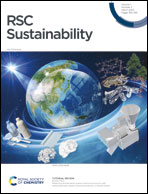From waste to wearable: an alternative waste stream for unusable textiles turned into piezoelectric textiles†
Abstract
In response to the growing fashion and textile industry, a market of reuse and recyclability to create alternative waste streams has emerged. With a more eco-friendly mindset, companies have begun to embrace clothing reuse through several means of recycling techniques (chemical, mechanical, thermal) or reuse; however, most spent clothing is disposed of. Herein, a novel method of recycling, for specific materials, is presented. From purchased secondhand clothing, made of either acrylic or nylon-6, an electronic textile is electrospun and implemented into a wearable smart mask demonstrating the feasibility with which textile waste can be transformed into a high performance energy generating and/or sensing material.

- This article is part of the themed collections: Sustainable fashion and Topic highlight: Sustainable materials


 Please wait while we load your content...
Please wait while we load your content...